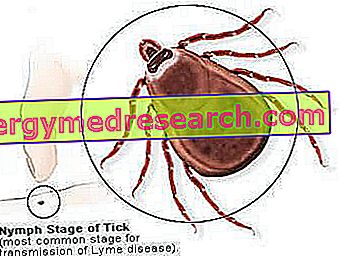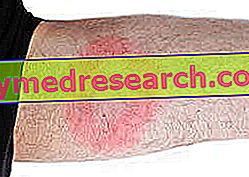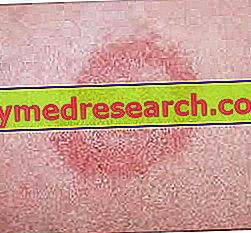What is Lyme disease?
Lyme disease is a pathology of bacterial origin that mainly affects the skin, but often internal organs, joints and the nervous system are also affected.
Lyme disease belongs to the anthropozoonosis group, that is to say that group of diseases that can be transmitted naturally from vertebrate animals to humans. In this specific case, the transmission of the disease is not direct but is mediated by an insect.
Infection carrier is a tick, which becomes infected after biting a sick animal and transmits the infection to the bitten man.
Incidence
" The disease that spreads most rapidly in the United States after AIDS ": this is what the New York Times called Lyme disease.

Lyme disease was first described around the mid-1970s, but the same symptoms were described in 1910, in Scandinavia.
1975 is remembered as the year of the Lyme disease epidemic, the same in which "unexplained" cases of arthritis were recorded (later revealed to be a consequence of Lyme disease); at that time the epidemic struck a small Connecticut town called Old Lyme (hence the name of the disease).
Ten years later, medical statistics have observed as many as 14, 000 patients suffering from this disease.
First discovered in America, Lyme disease currently has endemic outbreaks throughout the world, ranging from Japan to Canada, from Australia to Europe. In the United States alone, about 15-18 thousand cases are diagnosed per year.
In Italy the first human clinical case was reported in Genoa in 1983 and the first isolation of the germ responsible took place in Trieste in 1987. Currently, the regions most affected are Friuli Venezia Giulia, Liguria, Veneto, Emilia Romagna, Trentino Alto Adige, while in the central-southern regions and on the islands the reports are sporadic.
Causes
Lyme disease is considered a multi-system pathology, caused mainly by a spiral-shaped bacterium known as Borrelia burgdorferi . This spirochete has been identified as the causative agent of Lyme disease only in 1982, thanks to the studies of a biologist from Montana, Dr. Burgdorfer (to whom we owe the name).
By virtue of the etiological agent, Lyme disease is also known as borelliosis .
Contagion
Lyme disease is not transmitted to humans directly by this bacteria: in fact, the bacterium infects ticks, which, in turn, through the bite can transmit the infection to humans and other animals.
Many mammals (eg deer, hedgehogs), birds and rodents, represent the ideal replication reservoir.
Subject to Risk for Lyme Disease
The categories at risk are people in contact with wildlife, hunting guards, foresters, breeders, veterinarians and hikers.
Ticks - in particular of the genus Ixodes - represent the vector of the disease: the beating is "collected" by the ticks, which, sucking the blood of the infected animals, transmit it through the bite to man and other animals.
Since Lyme disease has also been found in areas without ticks, it is believed that, exceptionally, it may also be carried by other blood-borne insects.
To transmit the infection to humans, the infected tick must adhere to the skin for more than 24 hours: in this way, repeated bites - however painless - favor the transmission of Borrelia through regurgitation, feces or saliva in the locus of same bite.
Infection with Borrelia burgdorferi does not give immunity, so Lyme disease can be contracted several times in life.
Symptoms in humans
To learn more: Symptoms Lyme disease
The incubation period of Lyme disease varies from 4 to 25 days, more frequently from 7 to 14 days; clinical manifestations may be early or late.
Typically, the typical symptoms of Lyme disease can be summarized in three main stages; however, the "stages" can sometimes overlap, thus manifesting themselves simultaneously.
Stages of Illness
- Generally, Lyme disease begins with a chronic migrating erythema .
It is a small red spot, not detected, which - over a period of time ranging from a few days to several weeks - extends to become a huge circular-oval or, in other cases, triangular spot. As shown in the photo, this spot is even more than 5 cm in diameter and often has a lighter central area.


See other photos Lyme disease Erythema is often accompanied by other peculiar symptoms, such as fever, muscle pain, physical fatigue, headache and neck stiffness.
In cases of severity, Lyme disease continues with cardiac, joint and / or neurological pain.
Sometimes, at this stage, the patient suffering from Lyme disease can also complain of dizziness, shortness of breath and / or inflammation at eye level.
- When Lyme disease is neglected or not carefully treated, it could cause long-term damage, damaging the nervous system and the skin.
Among the less frequent symptoms of Lyme disease, we also mention: difficulty concentrating, memory loss, mood changes, irritability.

As noted, the symptoms that accompany Lyme disease are multiple and heterogeneous: one patient may present only some signs, in others, however, the disease may generate more severe disorders. For these reasons, the diagnosis is not always immediate and simple.
In the next article, Lyme disease will be analyzed from a diagnostic, therapeutic and prophylactic point of view.
What to do if you get stung by a mint?
As anticipated, the transmission of the organism responsible for Lyme disease requires the tick to remain attached for a prolonged period of more than 24 to 36 hours.
Consequently, the removal of the tick is of fundamental importance and must be carried out as soon as possible, to avoid having a blood meal and inject the potentially infected saliva.
To detach the tick
- Do not use heat or substances such as petroleum, petroleum jelly, olive oils, etc.
- With tweezers, as close as possible to the skin, firmly grasp the tick
- Pull up gently and repeatedly without crushing it
- Disinfect the skin and tweezers with an antiseptic
In the 30 days following the puncture
- Consult a doctor
- Check the affected skin area, looking for the presence of a reddish patch around the puncture area
- Pay attention to the onset of fatigue, fever, malaise, headache, swollen glands and joint pain
- Taking antibiotics that could mask the symptoms confusing the diagnosis is not recommended.
Insights
Diagnosing Care Preventing Lyme Disease Medications to Treat Lyme Disease Lyme Disease in the Dog





